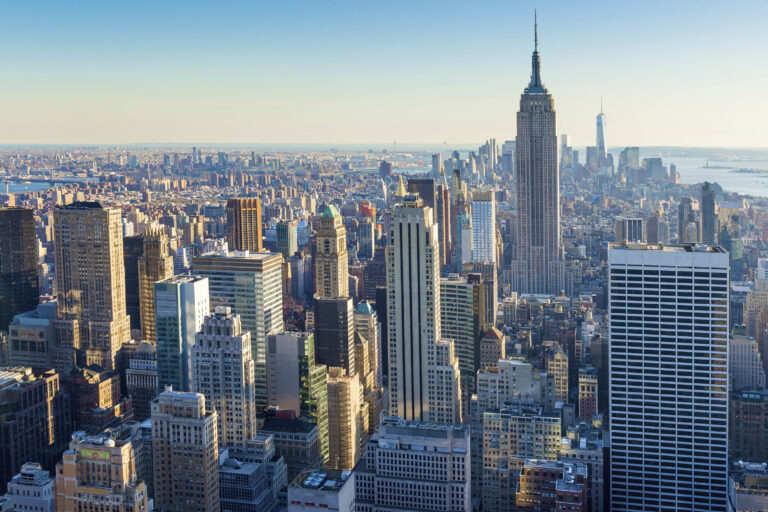Thinking about visiting the Big Apple but not sure when to go? Well, let’s talk about the worst time to visit New York.
Winter is undoubtedly the most challenging time to visit New York City. From December to February, the city experiences freezing temperatures, biting winds, and heavy snowfall, making exploring the city a frosty affair. Although the iconic holiday decorations and ice skating rinks lend a magical touch, preparing for the bone-chilling cold is a must. Bundle up with layers, wear warm accessories, and be prepared to navigate icy sidewalks to fully enjoy the city’s attractions. If you’re not a fan of the cold, it’s best to avoid visiting during this season.
High Season: The Crowded and Expensive Months
During the summer months from June to August, New York experiences high tourism, resulting in crowded attractions and inflated prices.
Tourist Crowds
Tourist hotspots such as Times Square and Central Park become extremely crowded, making it difficult to navigate and enjoy the sights. The bustling streets are filled with tourists from all over the world, adding to the congestion and making it a challenge to find a quiet spot to relax. Long lines and wait times become the norm, whether you’re trying to visit popular landmarks or dine at trendy restaurants. Despite its vibrant atmosphere, the never-ending stream of people can sometimes detract from the overall experience of exploring the city.
Peak Winter: Cold Weather and Limited Activities
The months of January and February in New York can be particularly challenging for visitors due to the extremely cold temperatures and limited outdoor activities available. With average temperatures dropping well below freezing, it is essential to bundle up and prepare for the frigid conditions.
During this time, outdoor attractions like Central Park and the High Line may have restricted hours or be temporarily closed due to the harsh weather. It is advisable to check ahead of time and plan indoor activities such as visiting museums, art galleries, or catching a Broadway show.
Hazardous Weather Conditions
Travelers in New York during the winter months may face hazardous weather conditions, including icy roads, sidewalks, and heavy snowfall. These conditions can result in disrupted flights, transportation delays, and limited options for outdoor exploration.
It is essential to stay updated on weather forecasts and plan accordingly. Dressing in layers, wearing proper footwear with good traction, and carrying necessary equipment like ice grips can help mitigate the risks associated with icy conditions. Additionally, it is recommended to allow extra travel time and have a backup plan in case of transportation disruptions.
Thanksgiving and Christmas: Festive, but Crowded
Visiting New York during the holiday season, particularly Thanksgiving and Christmas, may seem like a dream come true. The city is adorned with beautiful decorations, sparkling lights, and a festive atmosphere that is hard to resist. However, before you start planning your trip, it’s important to consider the potential downsides as well.
Bumper-to-Bumper Crowds
One of the biggest challenges of visiting New York during Thanksgiving and Christmas is dealing with the massive crowds. Popular attractions like Rockefeller Center and Fifth Avenue become congested with tourists from all over the world. Navigating through the sea of people can be overwhelming and time-consuming, taking away from the enjoyment of the holiday spirit.
Transition Words: Furthermore, Additionally, Moreover, In addition to, Not only, On the other hand
Therefore, it’s important to plan your visit carefully, keeping in mind the peak times and popular tourist spots. Arriving early in the morning or late in the evening can help you avoid some of the rush. Consider visiting lesser-known attractions or exploring other parts of the city to get a taste of the holiday charm without the chaos.
Maintaining Flexibility: Planning Alternatives
When considering a visit to New York, it is essential to maintain flexibility in your planning. One of the best ways to do this is by avoiding the peak tourist months and opting for the off-peak periods instead. April, May, September, and October are perfect examples of off-peak months when crowds are less overwhelming, and prices are more reasonable.
Pleasant Weather and Lower Prices
Visiting New York during the shoulder seasons offers several advantages. Firstly, you can expect milder temperatures, which make exploring the city much more enjoyable. Whether you want to take a leisurely stroll in Central Park, admire the city skyline from a rooftop bar, or enjoy outdoor events, the weather during the off-peak months is commonly pleasant.
In addition to the pleasant weather, the off-peak months also present an opportunity to save money on accommodations and attractions. As the tourist crowds thin out, many hotels and vacation rentals offer budget-friendly deals to attract visitors. Furthermore, popular tourist attractions and landmarks often have discounted prices or special offers during these months, allowing you to experience New York’s iconic sites without breaking the bank.
By choosing to visit New York during April, May, September, or October, not only can you avoid excessive crowds but also enjoy more reasonable prices for accommodations and attractions. This flexibility in your planning ensures a more pleasant and budget-friendly trip to the Big Apple.
Thank you for joining us on this journey through the darker side of New York City. While it’s easy to get caught up in the glamour and excitement of the Big Apple, it’s important to remember that there are some times when a visit may not be so pleasant. From scorching summers to bone-chilling winters, New York has its fair share of less-than-ideal weather. But fear not! With careful planning and a dash of resilience, you can still make the most of your trip and create unforgettable memories. So pack your bags, be prepared, and get ready to experience the bustling streets and vibrant energy of New York City.
